Virginia State Police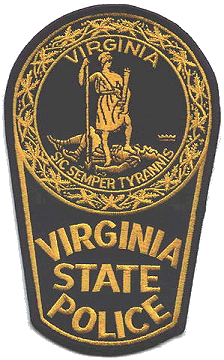
Virginia State Police
As early as 1906 when Virginia began registering motor vehicles,The Secretary of Commonwealth was also responsible for the regulatory sections of the new law dealing with traffic movement. His staff was minimal and the burden was left to sheriffs, constables and other law enforcement personnel. No adequate state-administered staff existed to enforce the laws pertaining to motor vehicles traveling the often unnavigable dirt roads of the State during the first two decades of the twentieth century.
Limited enforcement continued during the early 1920's, and by 1922,The General Assembly acknowledged the need for paid professional personnel to enforce the Automobile Acts. Eight inspector positions were created. These eight men comprised the Commonwealth’s Enforcement Division.
On March 24, 1923 the Division of Motor Vehicles was created and became a separate department of state government. The Secretary of Commonwealth transferred the enforcement powers of its office, which it had possessed since 1906, to the newly created DMV.
A motorcycle patrol force was formed within the Division . The "mechanical mule," as it was irreverently named by its courageous operators, became a part of the State Police mobile patrol for the next 30 years. In 1928,The Division of Motor Vehicles was authorized to hire 20 additional inspectors. Five hundred applications were received and the Virginia Highway Patrol grew to a total of 51. Motor vehicle operation was clearly not on the agenda as it is stated that one new inspector was issued a 1928 Ford which he could not drive because it had a "shifter" and he had never driven an automobile with a shift. It was insisted that he take the vehicle to his appointed station at West Point. This was completed with a chauffeur and upon arrival, the inspector was taught how to drive by the local chief of police.
In addition to highway patrol and the enforcement of motor vehicle statutes, the inspectors began pursuing traffickers of illegal whiskey. Hundreds of violators were apprehended during prohibition days. Many pursuits ensued over paved roads, dirt roads and paths through woods.
In 1932, Inspectors became empowered to enforce criminal codes, as well as motor vehicle codes. In doing so, legislators created a state enforcement group with the power of arrest anywhere in Virginia. A mobile enforcement agency was now ready for duty wherever civil strife or emergency conditions might exist that would warrant police personnel to ensure peace and security. It was at this time that inspectors began to be known as "troopers". White motorcycles and white roadsters were issued to inspectors and the citizens became acquainted with what was referred to as "The Great White Fleet." Chevrolet agreed to sell the Division new models for $250 each. Sirens were mounted on the right running boards and both doors bore the Seal of Virginia. On the rear of the car was identification of "Division of Motor Vehicles" and the admonition "Drive Carefully - Save Lives."
100 black and white Ford V-8s were delivered to the Division of Motor Vehicles in December of 1935. Equipment was to include safety glass, leather upholstery, twin taillights, two license plate brackets, horns and a siren. November 3, 1938, an executive order officially adopted the title of "State Trooper." The purpose of this was to identify specific members of the Division of Motor Vehicles performing in the roles of inspector and motorcycle deputy. The title of examiner remained in effect and identified those members responsible for issuing operator’s and chauffeur’s licenses. Troopers were issued a badge with a number that corresponded with the license numbers of their vehicles. Virginia State Police replaced "Commonwealth of Virginia Division of Motor Vehicles" on these plates. Unmarked patrol cars commenced service in 1940, and the following year, Twenty-five new white cars were added to "The Great White Fleet."
Unmarked black cars displaying regular issued license plates were used to apprehend habitual traffic law violators. On March 14, 1942, the General Assembly abolished the existing Division of Motor Vehicles and created two separate agencies: The Division of Motor Vehicles and The Department of State Police. With this separation, the State Police became responsible for its own communication system, vehicle garage and the administration, training, discipline and assignment of examiners of applications for operator’s and chauffeur’s licenses. The duties of the State Police also included supervision of inspection stations, the motor vehicle appliances, accessories and safety devices.
In 1948, A distinctive color scheme was designed of State Police patrol vehicles. The blue and gray automobiles enabled the motoring public to easily recognize State Police vehicles when assistance was needed and to help deter would-be traffic violators. Twelve motorcycles were purchased for special occasions and not for daily highway patrol. At large functions which attracted scores of tourists, traffic handling and control by automobiles was difficult but readily expedited by troopers on motorcycles.
In 1952, reflective markings which were easily recognizable at night marked the front, rear and sides of State Police vehicles. The lesser seal of the Commonwealth was placed on each side of the vehicle between "State" and "Police." In 1954, the VSP began to phase-out motorcycles.
In 1961,The canine program was instituted to afford the State Police and all enforcement agencies the tracking abilities of German shepherd dogs. One trooper and canine were assigned to each State Police division. In 1982, the VSP began enforcing a vehicle emissions inspection law in Northern Virginia. The motor carrier safety and hazardous materials units were also created in 1982. Staffed by troopers in each division, they ensured the safety of commercial motor carriers and buses. The Motor Carrier Safety Unit provided in-depth investigation of commercial vehicle crashes and enforced rules and regulations involving the transportation of hazardous materials. In 1985, the VSP went from red overhead lights to blue.
In 1987,The Department reinstituted the use of motorcycles to help control traffic and assist motorists in the highly congested areas of Northern Virginia and Tidewater. The motorcycles were Harley-Davidson model FXRPs and were painted the Department’s traditional blue and gray.
The mission of the Virginia State Police is to provide the Commonwealth with a responsive, coordinated, composite statewide police department, independent yet supportive of local law enforcement agencies; to preserve law and order; to enforce traffic and regulatory laws; and, to provide security and safety services to citizens of Virginia.
The earliest record of license plate use for VA state traffic law enforcement was Virginia passenger car license plate number 99-996 displayed on the patrol car of an Inspector of the Virginia Commissioner of Motor Vehicles. It was stated that license plates in the 99-900 series were reserved for use on MV Inspector patrol cars during that time.
A 1928 Virginia license plate, number 99-523 was discovered and believed likely to have been utilized by an Inspector of the Commonwealth of Virginia Division of Motor Vehicles.
These officers not only conducted highway patrol and enforced traffic laws prior to the official formation of the Virginia State Police, but also enforced Prohibition Laws at the time.
In 1933, the "Great White Fleet" of the Virginia State Police was issued an embossed steel license plate measuring 5 3/8" x 11 3/4" with a debossed border. The plate featured four round mounting holes in each corner and four mounting slots midway to the center of the plate. STATE over POLICE was embossed in black over white. These "sign plates" were run in conjunction with the standard 99-9## passenger license plates on the patrol car as seen in the 1933 photo below.
What makes these license plates particularly interesting, is that after their short use by the VSP, the STATE POLICE "sign plates" were subsequently given to the West Virginia State Police to run on their fleet. A visit to the West Virginia State Police page on this website will even show this type of license plate in use there during the mid 1930's.
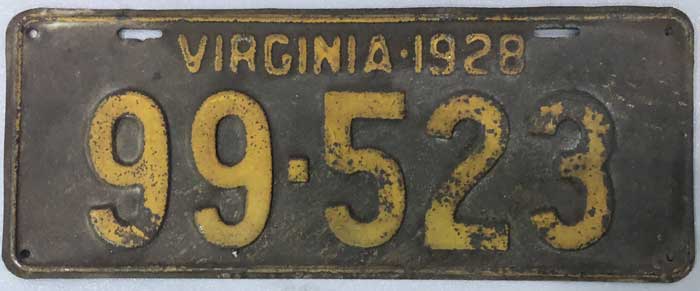 1928 Possible Division of Motor Vehicles Inspector issue.
1928 Possible Division of Motor Vehicles Inspector issue.
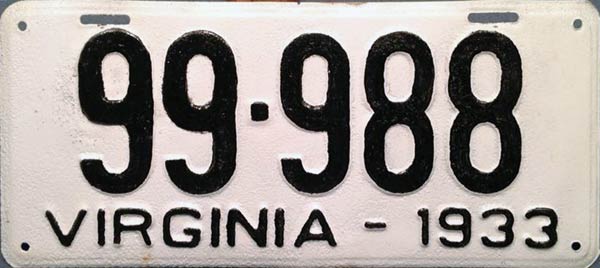 1933 reserved series issue.
1933 reserved series issue. 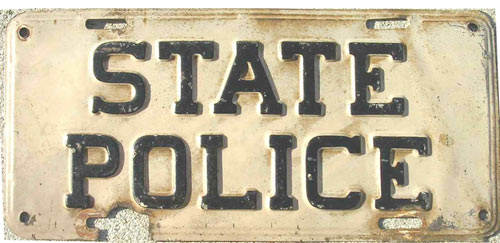 1933-1934 issue.
1933-1934 issue. 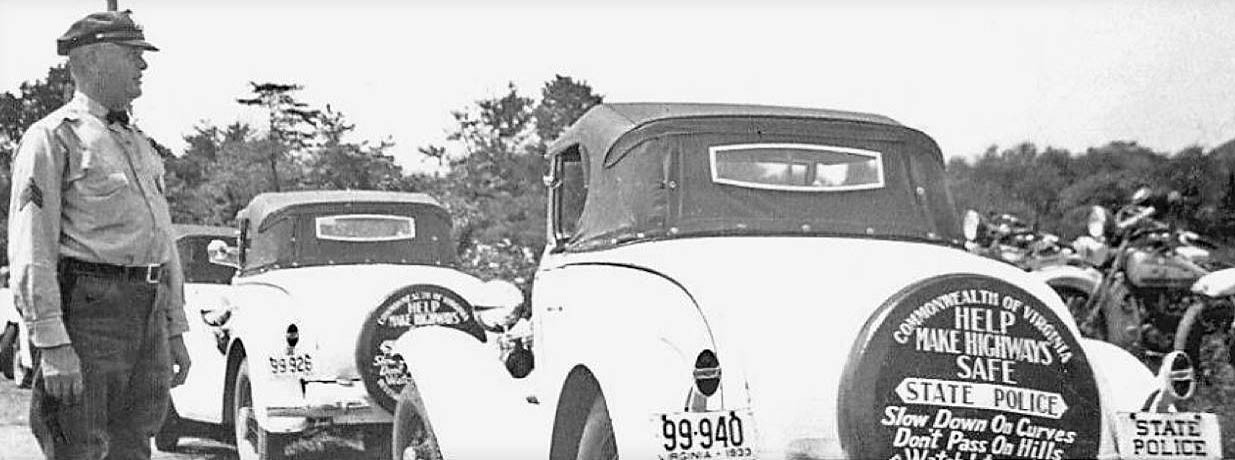 1933 Virginia State Police showing 99-9## series plates and STATE POLICE title plate.
1933 Virginia State Police showing 99-9## series plates and STATE POLICE title plate.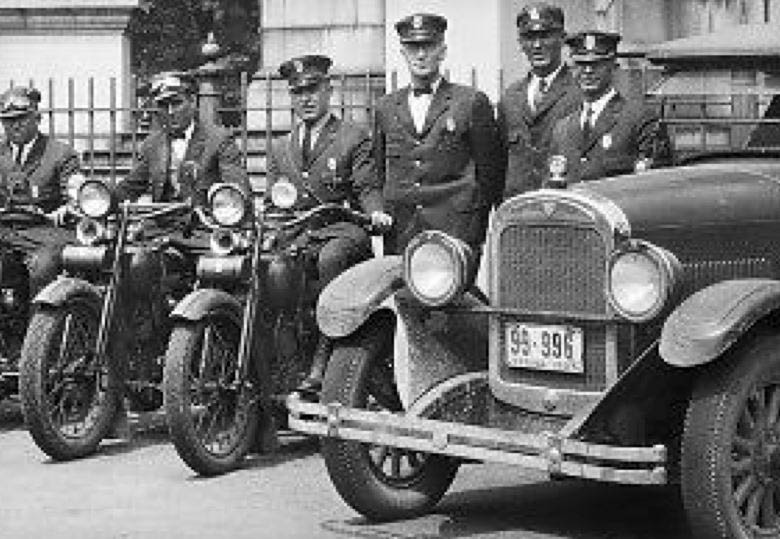 1933- 99-996
1933- 99-996The next issue license plate issued to the Virginia State Police has caused some debate as to when it was issued/used as well. The plate is made of embossed steel and measures 6" x 14 3/4". The color is orange over black. VIRGINIA is embossed in "flattened dies" between the top mounting slots. STATE over POLICE is embossed at the left side of the plate and encroaches to just past the center of the plate, leaving the right 1/3 of the plate to the embossed assignment number up to three digits. The plate also has an embossed painted border.
Some believe that this license plate was issued in 1931. This could be accepted if the construction and die types were contemporaneous for 1931. These number dies did not begin use in Virginia until 1933. It is entirely possible that this issue was introduced in 1933 and used concurrent with the black on white STATE POLICE plate with the latter being run only on the front of the patrol car while the numbered plate was fastened to the rear.
However the most likely hypothesis for the issuance of this VSP license plate would place it from 1934 until 1936, as there is no other example of VSP license plate for that time frame.
Again, we have to rely on confirmed information to determine otherwise.
It must also be stated for the record, that during 1934, passenger license plates in the 99-900 number bloc were still being used by both VSP and the DMV with a thin metal strip attached to the top of the passenger license plate identifying either agency. There are no known surviving examples of these title strip attachments.
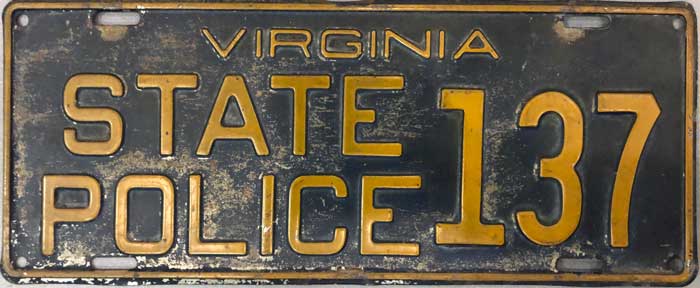 Circa Late 1933-1936 issue.
Circa Late 1933-1936 issue. 
The next issue license plate for the Virginia State Police causes less confusion and debate. The plates were introduced in 1936 and were made of embossed steel and measuring 5 3/8" x 11 3/4". VIRGINIA embossed at the top center of the plate with STATE over POLICE embossed on the center left field and the shield number of the trooper embossed on the right side of the plate. The plates were colored orange over dark blue. This issue was used until 1940.
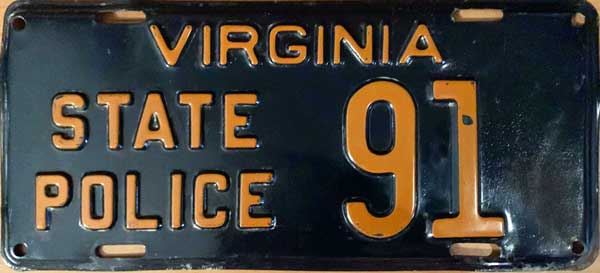 1936-1940 issue. Embossed steel.
1936-1940 issue. Embossed steel.

In 1940, the Virginia State Police introduced a distinctive dark blue over grey license plate similar in layout to the previous 1936 issue. The state name was centered at the top, STATE over POLICE on the left side of the plate and the assignment number to the right. This coloring and format lasted for the next forty years with exceptions only in the material, construction and color shades which will be outlined further below.
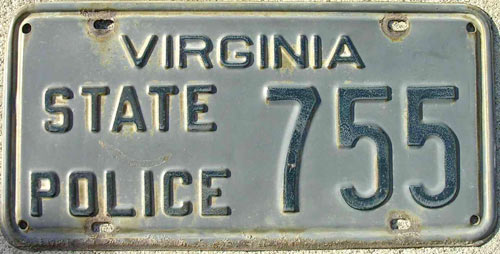 Circa 1948- 1966 issue.
Circa 1948- 1966 issue. 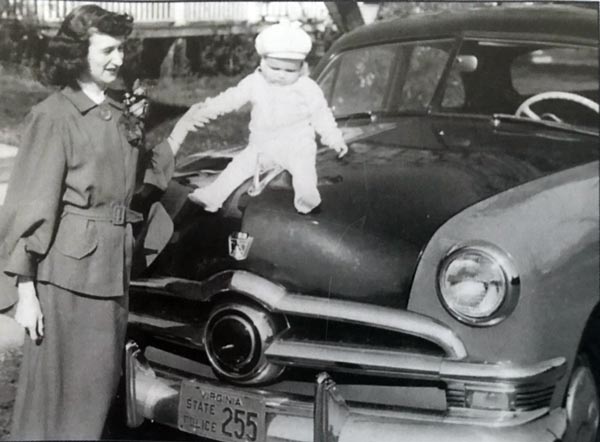 Circa 1949 already utilizing the 6" x 12" dimension plates.
Circa 1949 already utilizing the 6" x 12" dimension plates.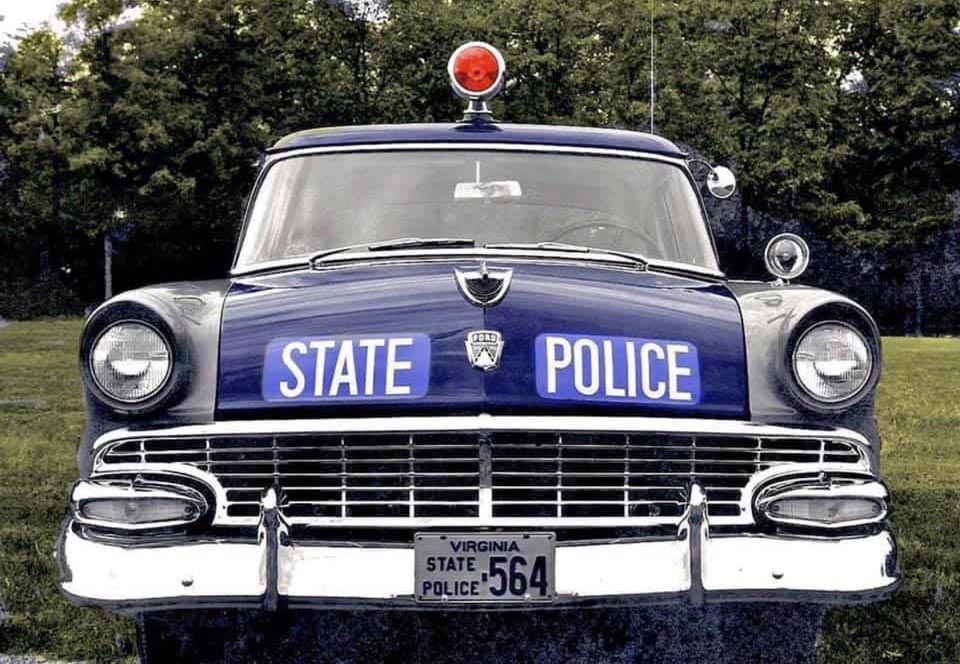 (Courtesy Jim Aitken)
(Courtesy Jim Aitken)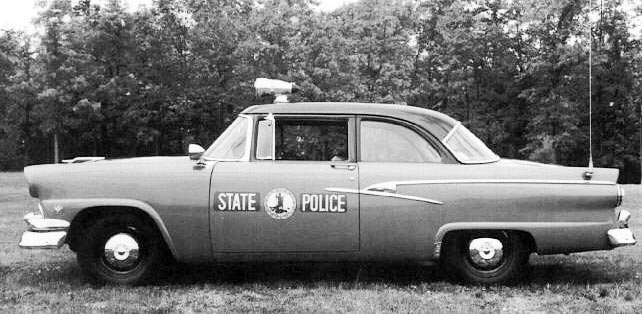
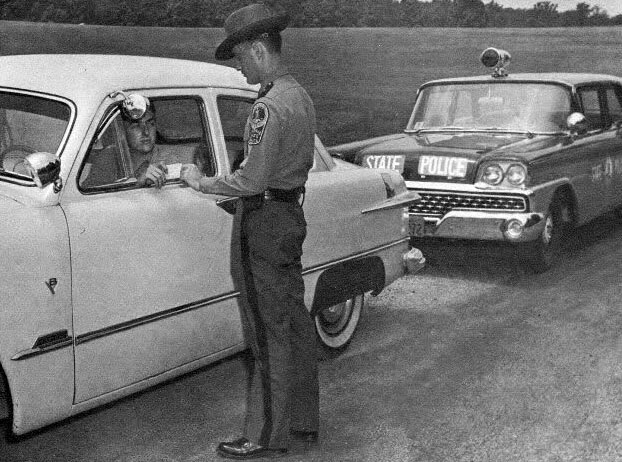
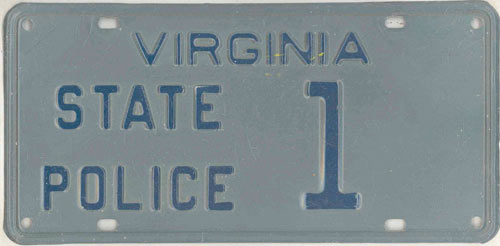 Circa 1948- 1966 Superintendent issue.
Circa 1948- 1966 Superintendent issue. 
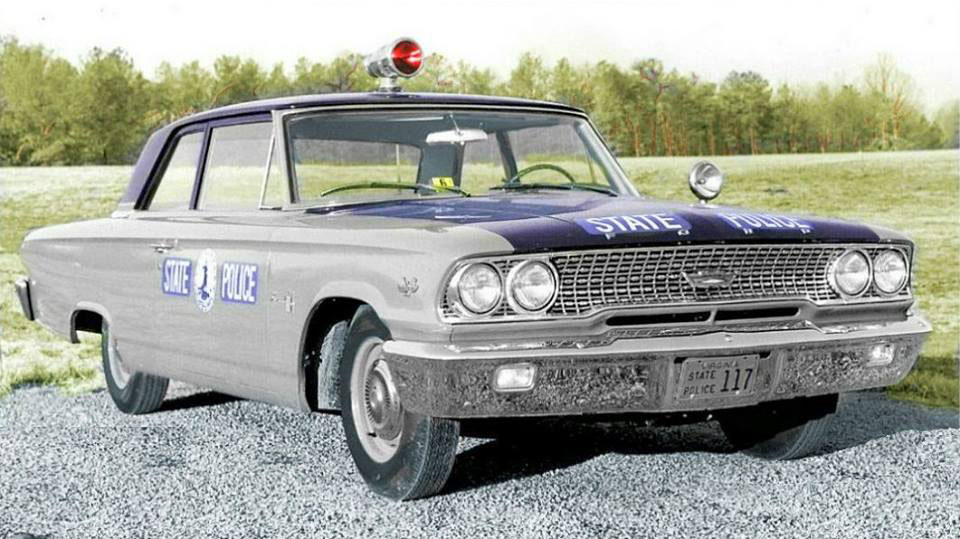
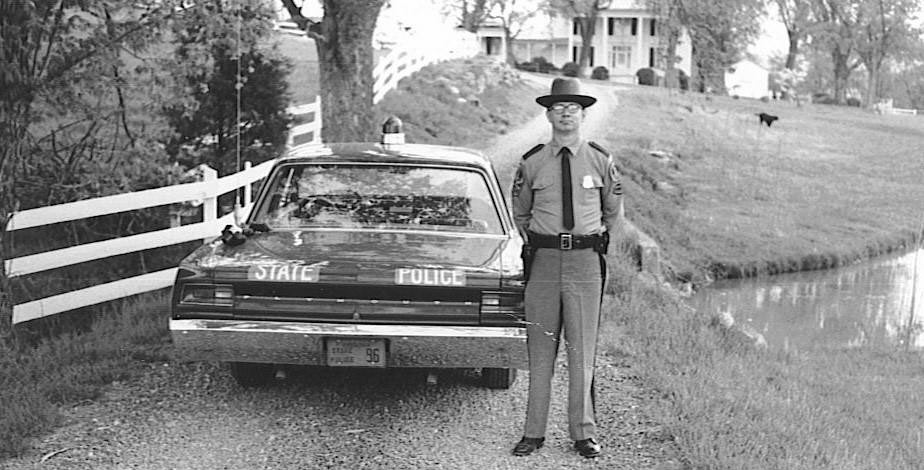
In 1967, the four corner holes were dropped, but the four short oval slots were still used on the embossed steel base with the debossed border until the end of 1971. In 1972, Virginia license plates went to an embossed painted border. Therefore an embossed steel VSP plate with a raised painted border would have been issued between 1972 and 1976.
It was in 1976 that Virginia license plates were made of embossed aluminum and began using round mounting holes instead of short oval slots.
It was also on the 1976-1981 aluminum base where the dark blue character numbers were substituted with dull black.
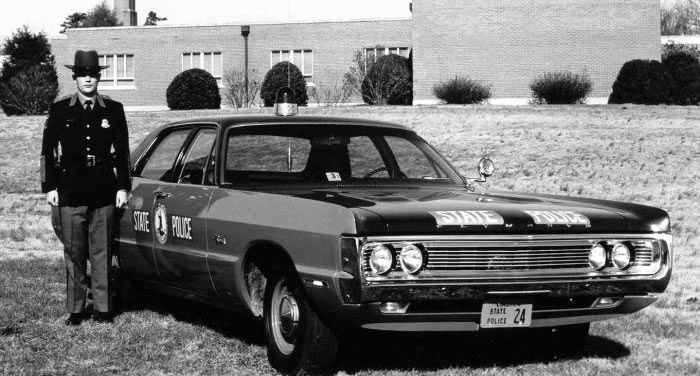
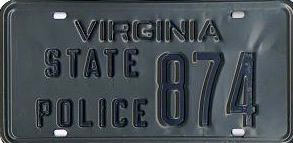 1967-1971 issue. Embossed steel.
1967-1971 issue. Embossed steel.
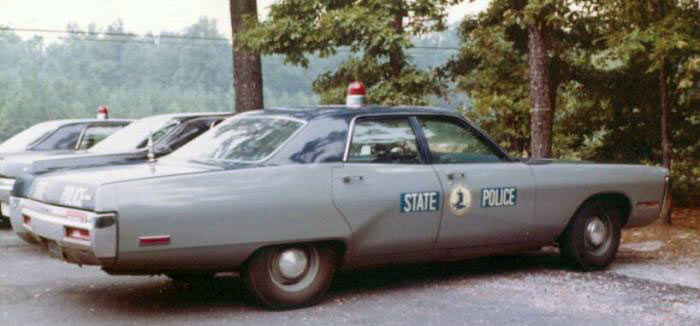
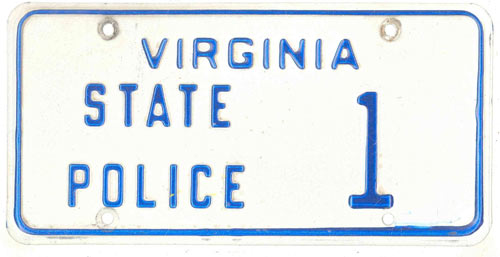 1976-1981 Superintendent issue.
1976-1981 Superintendent issue.
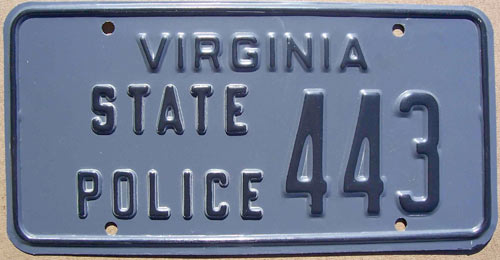 1976-1981 issue. Embossed aluminum.
1976-1981 issue. Embossed aluminum.
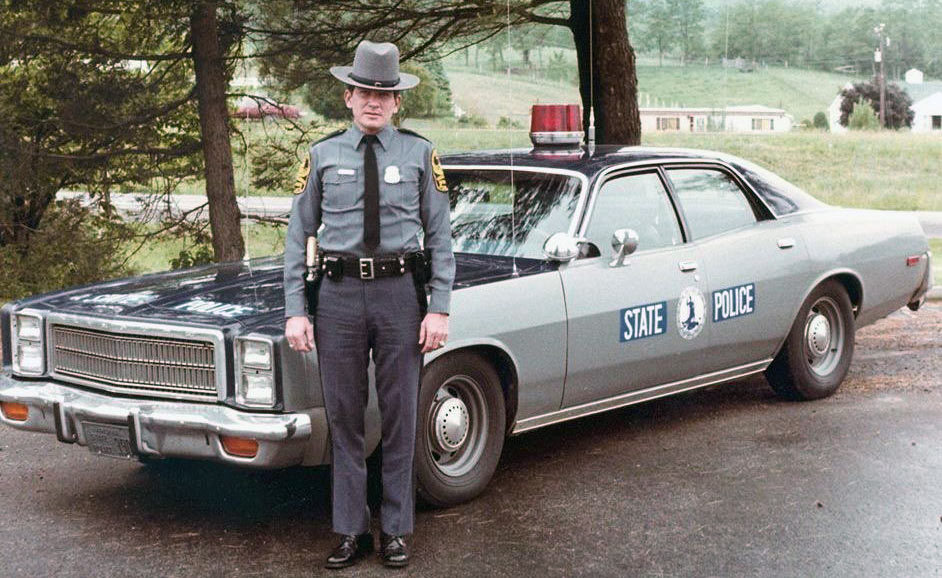
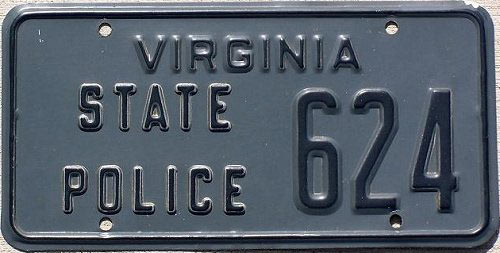 1976-1981 issue. Embossed aluminum.
1976-1981 issue. Embossed aluminum.

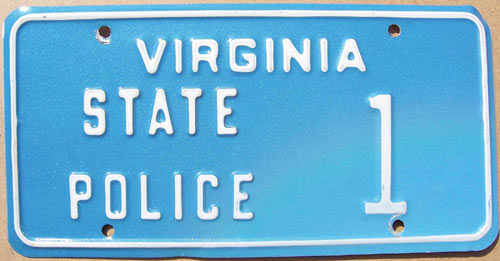 1976-1981 Superintendent prototype issue.
1976-1981 Superintendent prototype issue.
The state of Virginia did a statewide "re-plate" in 1981. The new aluminum license plates had embossed numerals and border. The state name this time was silkscreened in dark blue at the top center of the plate. VSP license plates continued with STATE over POLICE embossed at the far left side of the plate with a number up to three digits embossed to the right.
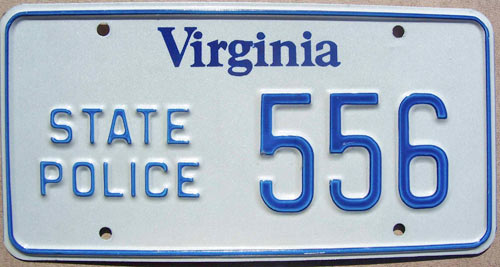 1981-1987 issue. Embossed aluminum.
1981-1987 issue. Embossed aluminum.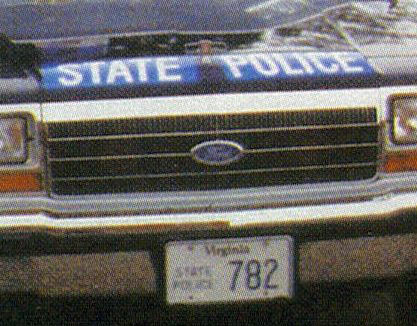
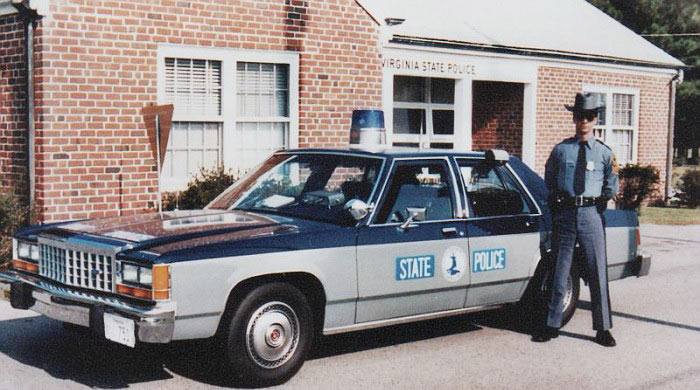
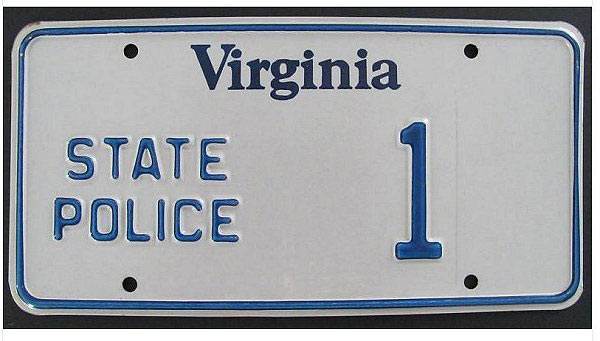 1981-1987 Superintendent issue. Embossed aluminum.
1981-1987 Superintendent issue. Embossed aluminum.
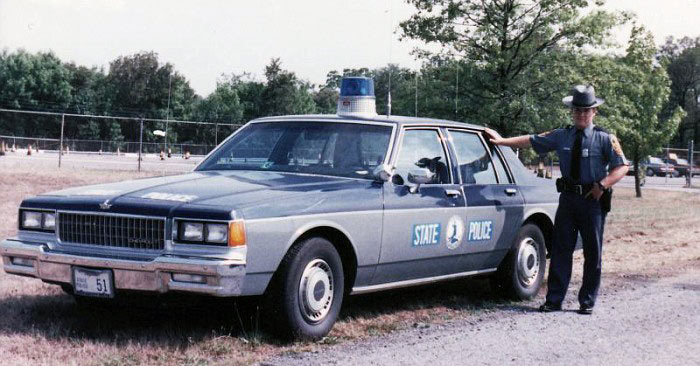
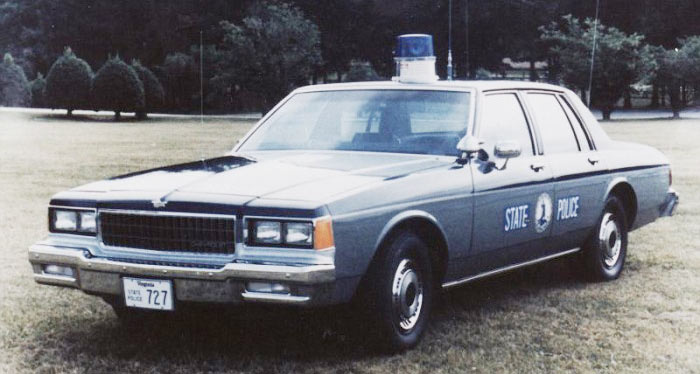
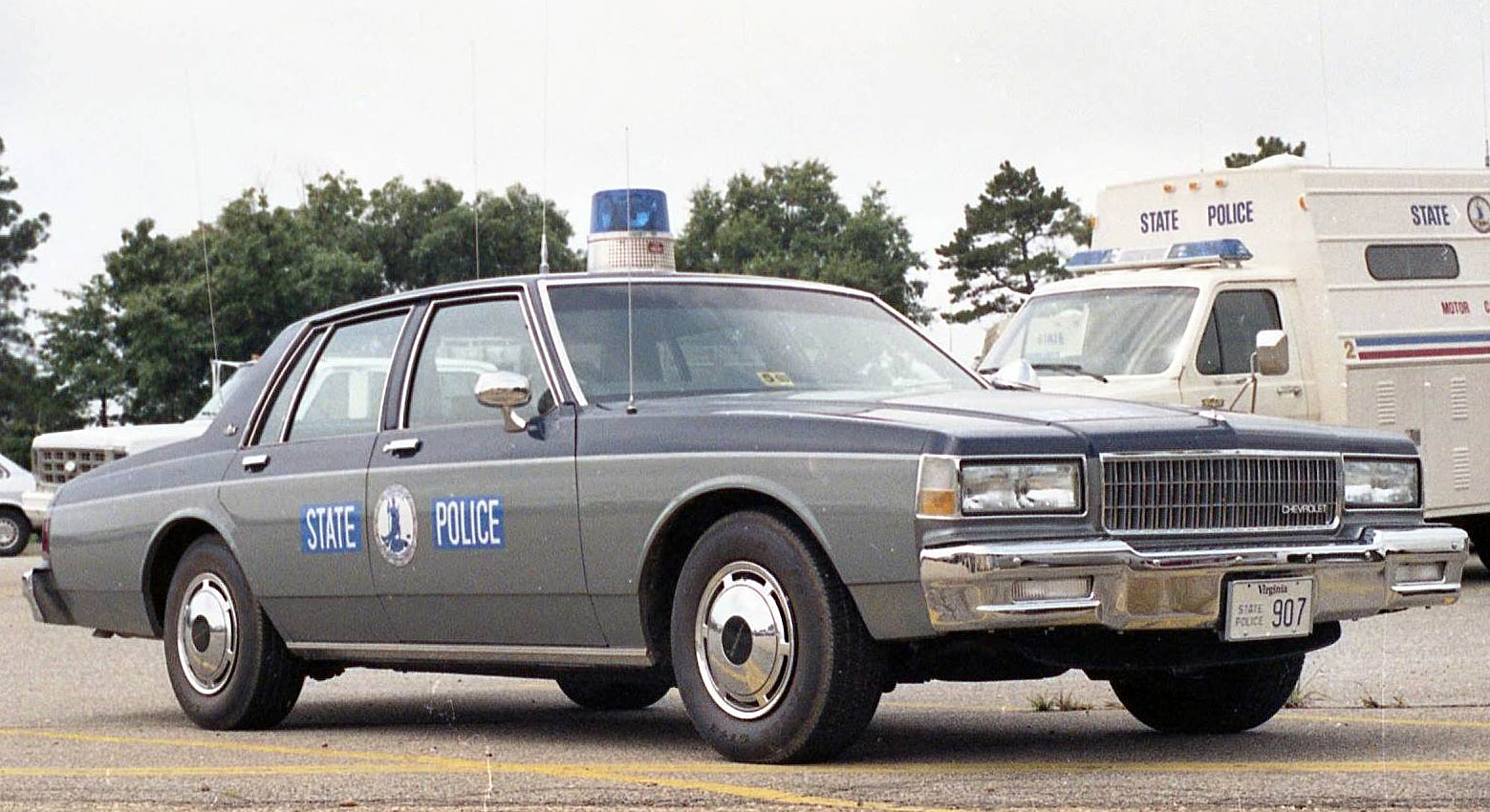 (Courtesy Darryl Lindsay)
(Courtesy Darryl Lindsay)In 1987, a slight change took place with VSP license plates. The color and formatting remained the same, however STATE over POLICE on the left side of the license plate was silkscreened rather than embossed.
The assignment number had also climbed to four digits and the dies used for the nuumbers were more ornate.
These plates were used until 1991.
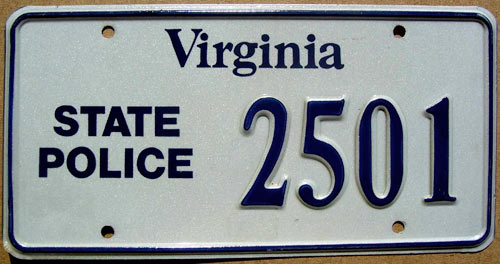 1987-1991 issue. Embossed aluminum.
1987-1991 issue. Embossed aluminum.

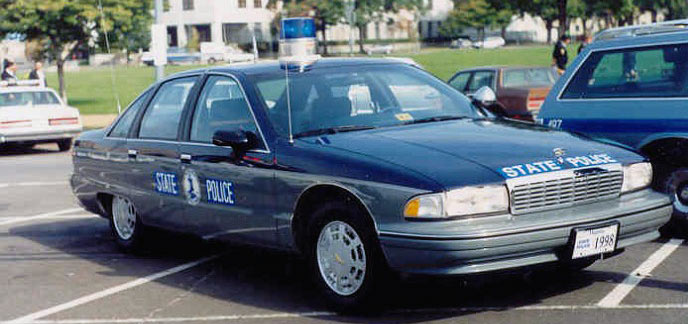
 1987-1991 issue.
1987-1991 issue.
1991 saw the unveiling of a spectacular graphic-design license plate issued for the entire marked fleet of the VSP. The plate had dark blue embossed numerals over a reflective background. The state name was silkscreened in large blue letters at the top center of the plate. STATE POLICE was silkscreened in blue between the lower mounting holes. A large graphic of the Virginia State Police badge occupied the left center field of the plate with the assignment number embossed to the right of it.
These plates also had an embossed border painted in blue.
These plates were known soon enough as the "badge tag".
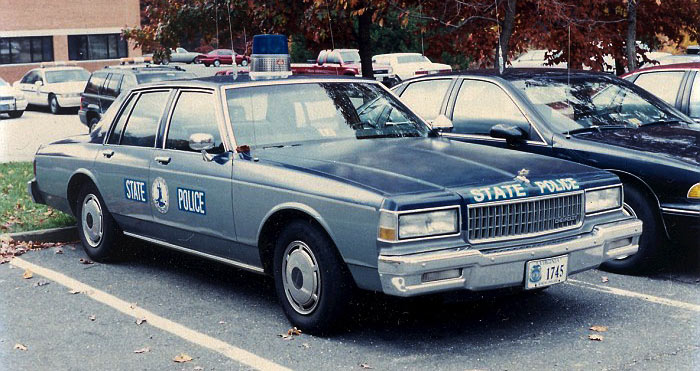
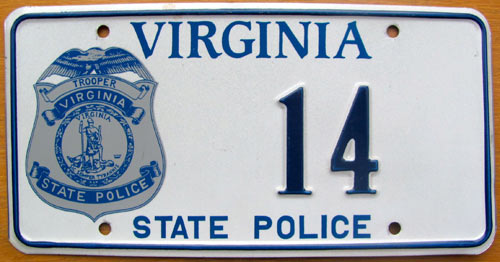 1991-1993 "badge tag" issue.
1991-1993 "badge tag" issue. 
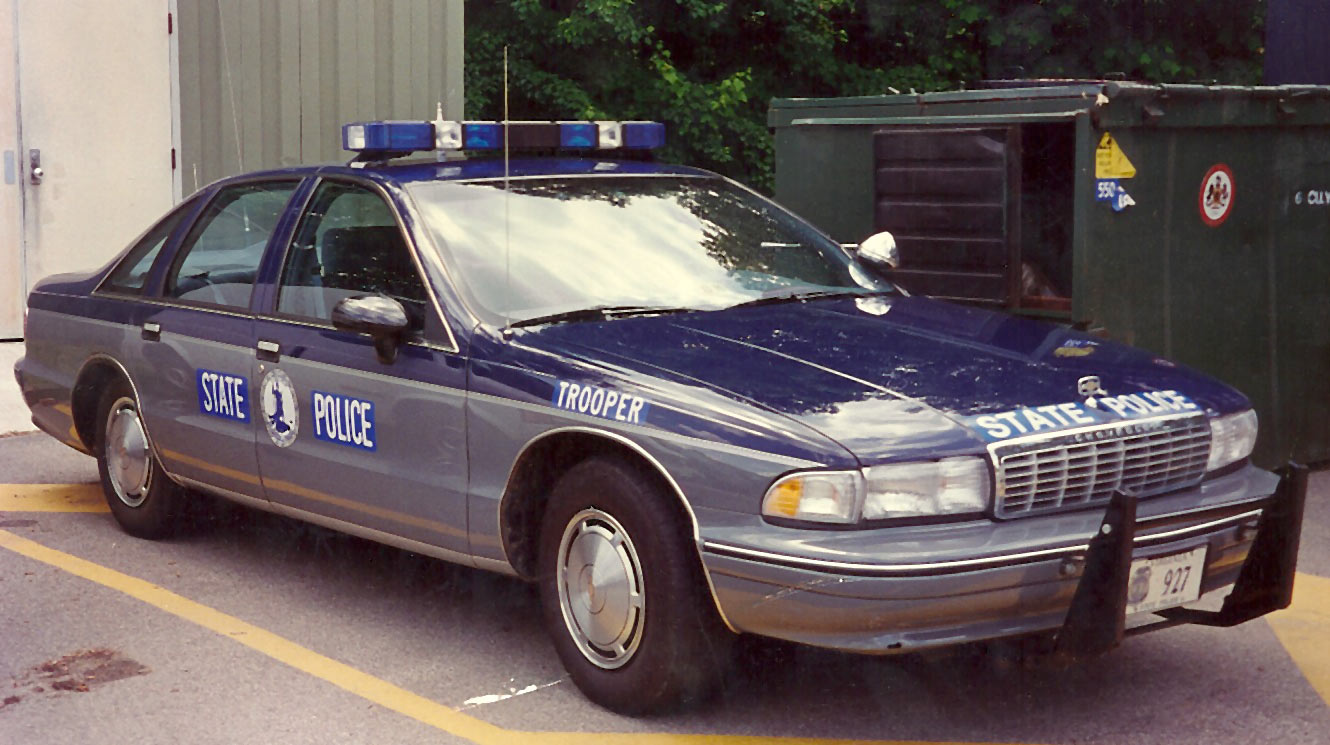
In 1993, Virginia license plates dropped the embossed painted border in favor of a step border.
VSP license plates followed suit, but still maintained the clean attractive graphic layout that was introduced in 1991.
This style continues to this day with only the sequential numbering climbing higher and higher.
As of 2015, the assignment numbers climbed into the 5900 number bloc.
By 2023 those numbers had climed into the early 8000's.

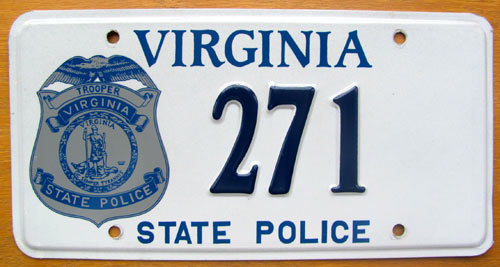 1993-2022 issue.
1993-2022 issue. 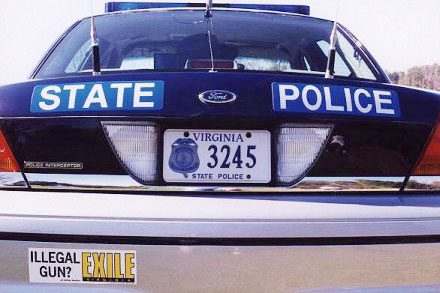
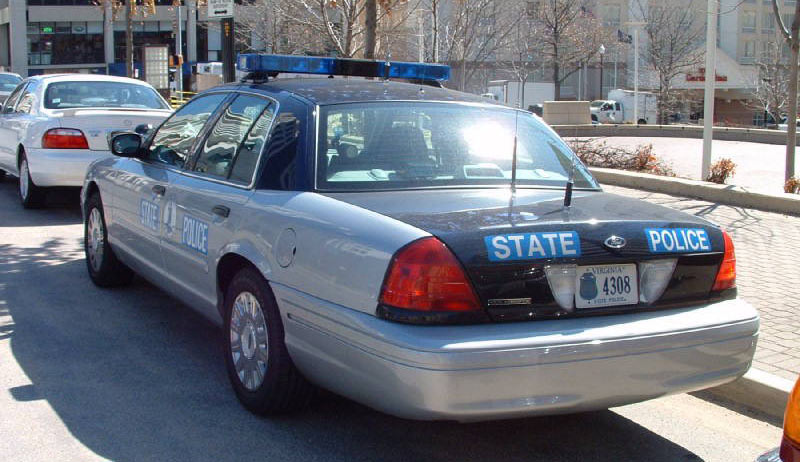

 1993-2022 issue.
1993-2022 issue. 
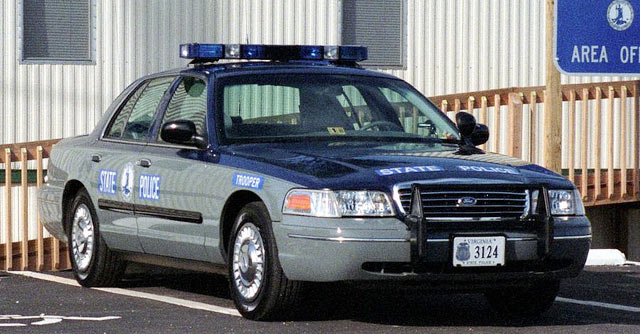
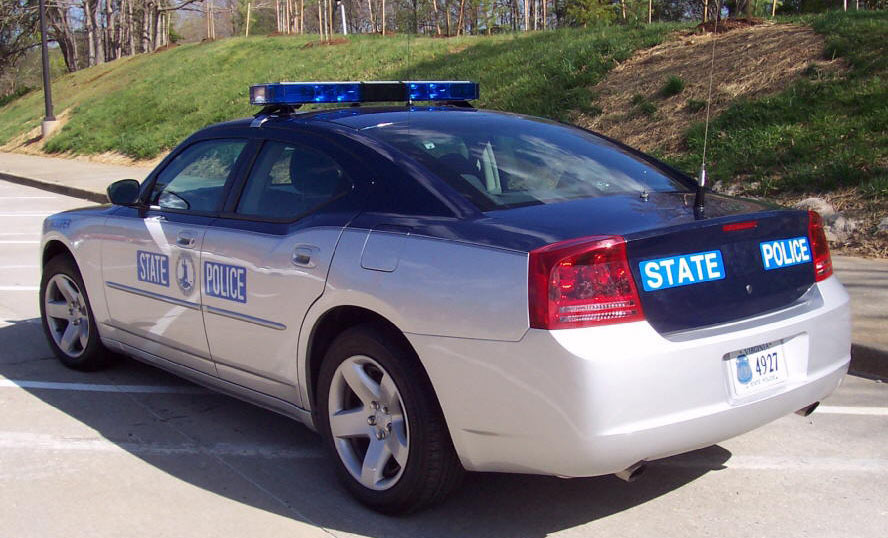
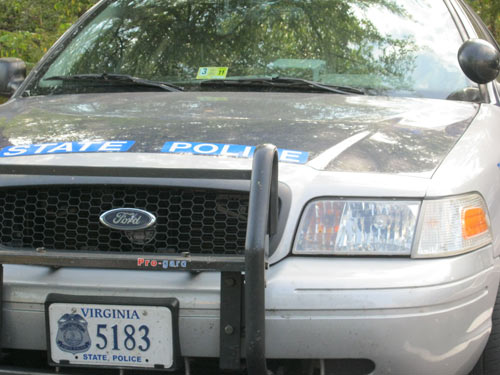
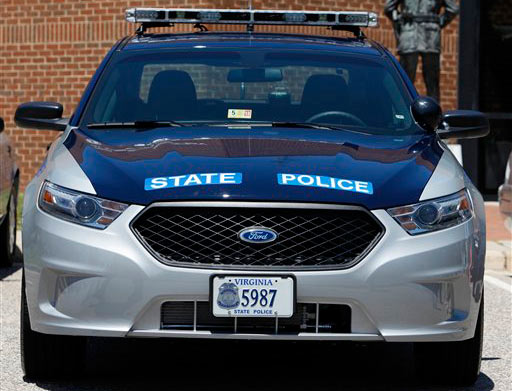
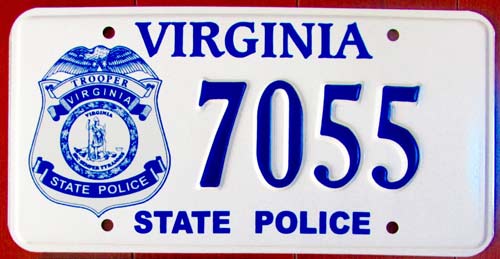 2016-Current issue.
2016-Current issue. 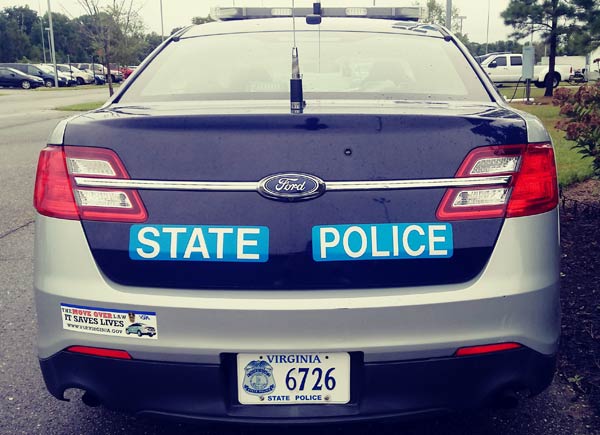 (Courtesy Russ Penka)
(Courtesy Russ Penka)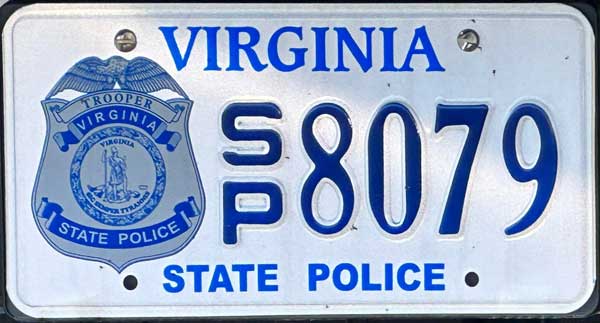 2022-2024 issue.
2022-2024 issue.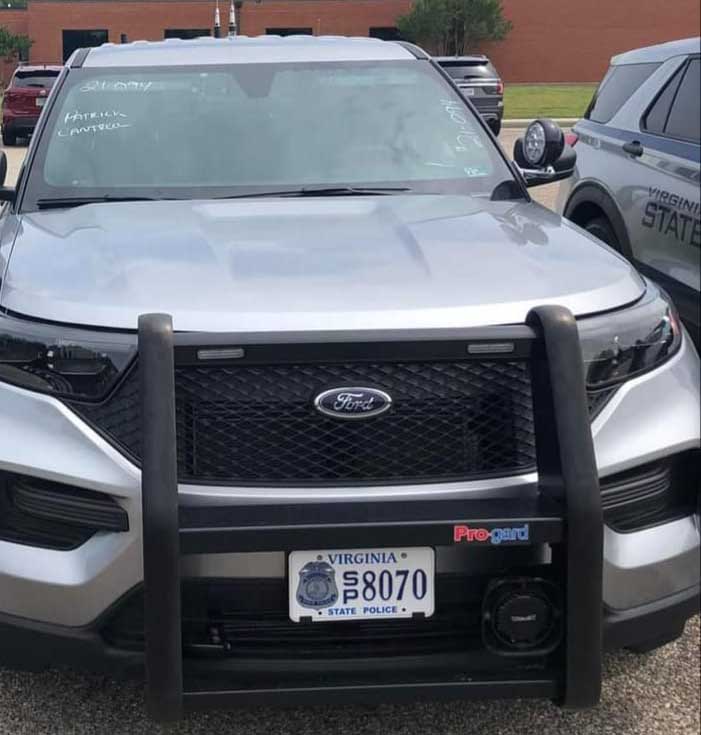 2022- Stacked SP prefix discontinued in 2024.
2022- Stacked SP prefix discontinued in 2024.Inspectors with the Virginia Department of Motor Vehicles drove motorcycles on patrol that sported regular motorcycle license plates. A photo from 1925 indicates plate number 2460 mounted on the motorcycle of such an inspector.
Much like the black and white VSP car license plates in 1933, a smaller version of the same plate was used for the motorcycle license plates. These plates were also given to the West Virginia State Police by the mid 1930's.
It's not known what kind of license plates were used on VSP motorcycles until they were disbanded from the fleet in 1954.
When motorcycles made a resurgence in the 1980's, smaller versions of VSP car license plates were used.
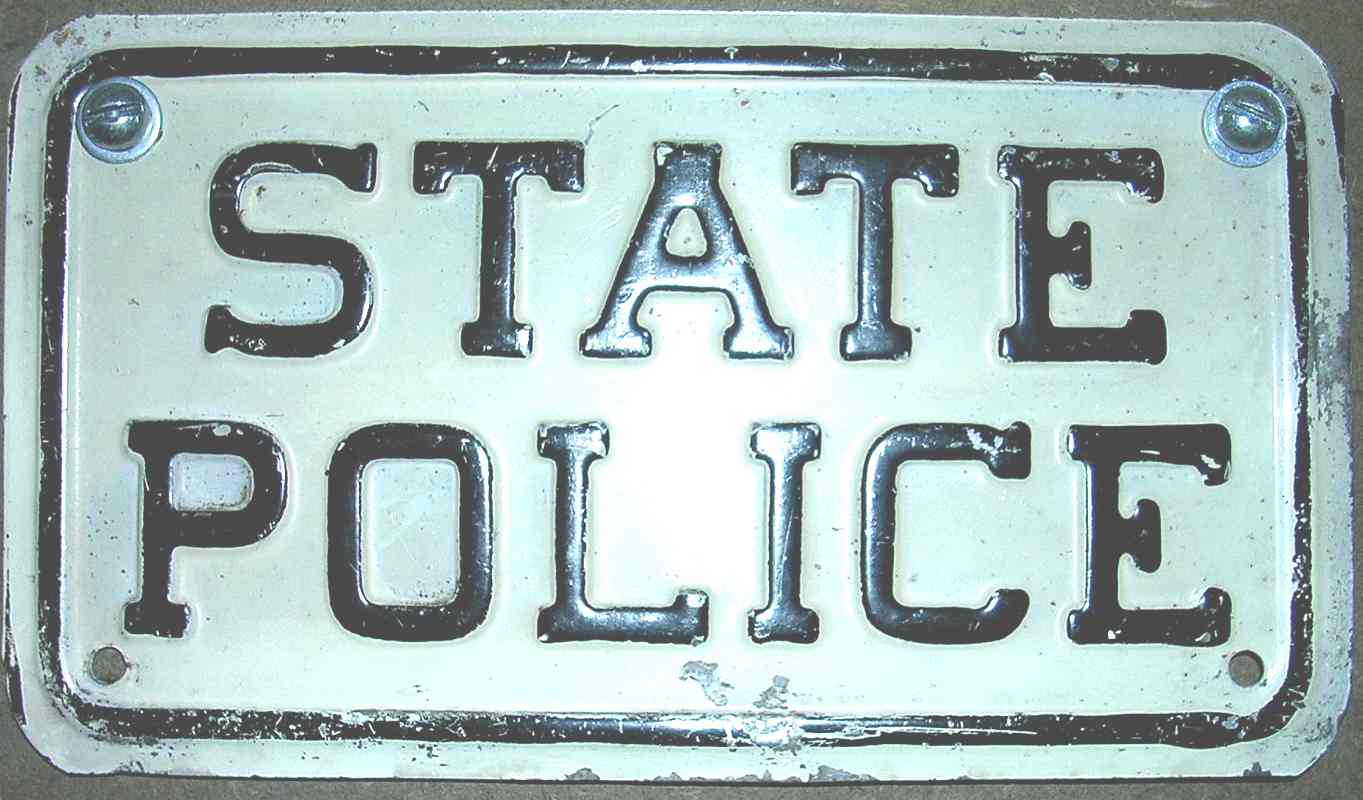 Circa 1933-1934 motorcycle issue. Embossed steel.
Circa 1933-1934 motorcycle issue. Embossed steel.
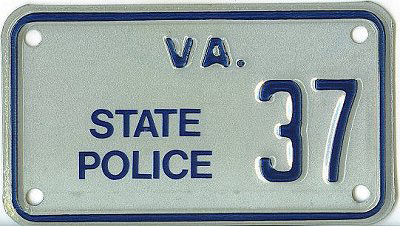 Circa 1987-1991 motorcycle issue.
Circa 1987-1991 motorcycle issue.
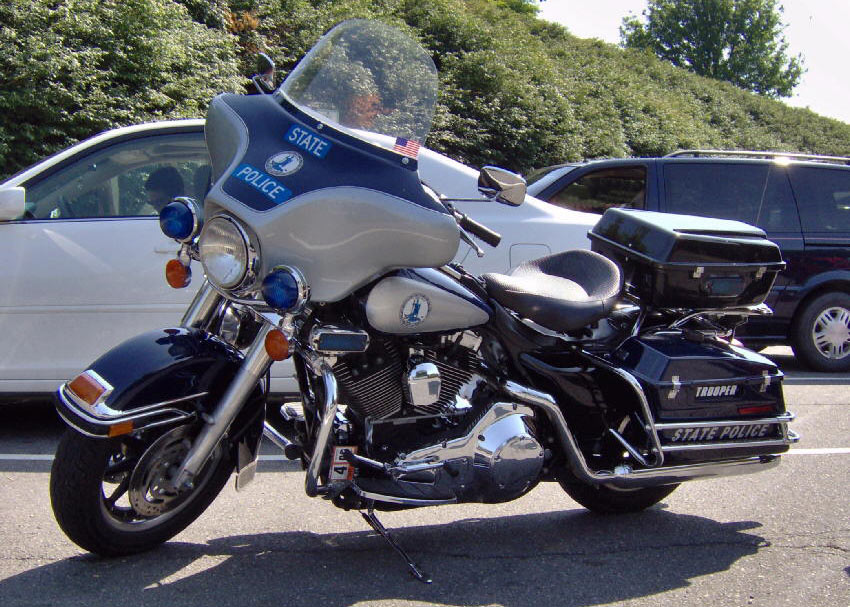
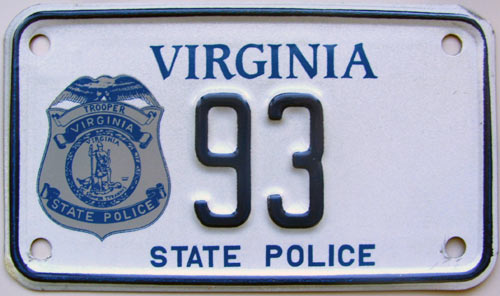 1991-1993 motorcycle issue.
1991-1993 motorcycle issue.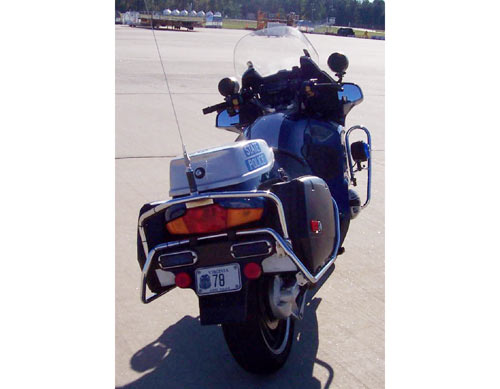
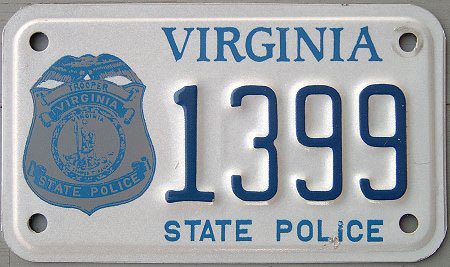 1993-Current motorcycle issue.
1993-Current motorcycle issue.
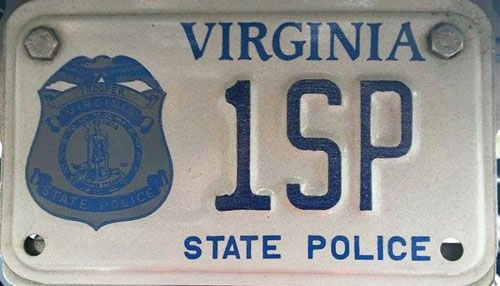 2014-Current motorcycle issue.
2014-Current motorcycle issue.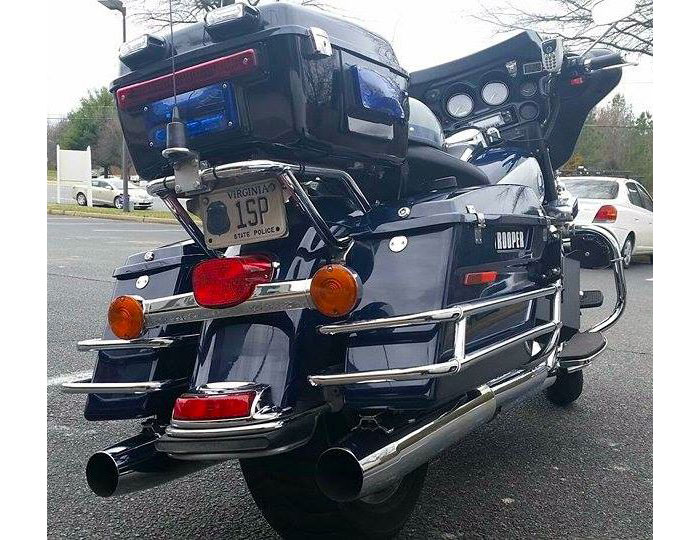
The following are plates used both officially and unofficially regarding the Virginia State Police
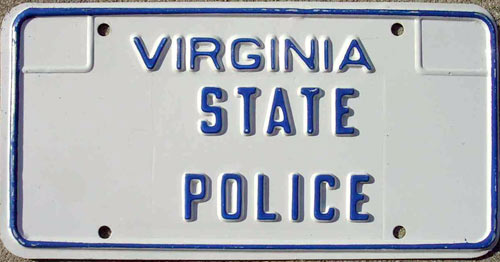 Test blank circa 1973.
Test blank circa 1973.  Circa 1970's embossed aluminum "dash plate" used for unmarked vehicles.
Circa 1970's embossed aluminum "dash plate" used for unmarked vehicles.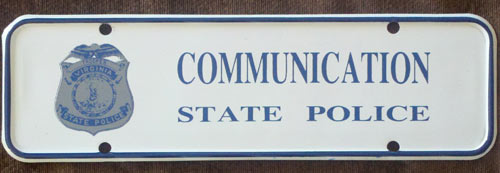 1990's-2000's screened aluminum attachment for communication VSP staff.
1990's-2000's screened aluminum attachment for communication VSP staff. 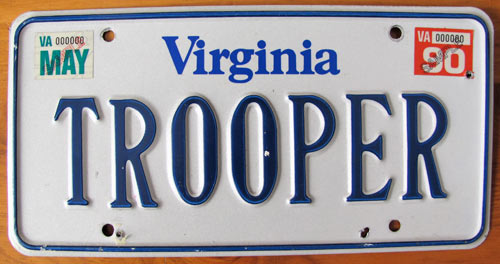 1990 National Troopers Coalition souvenir.
1990 National Troopers Coalition souvenir.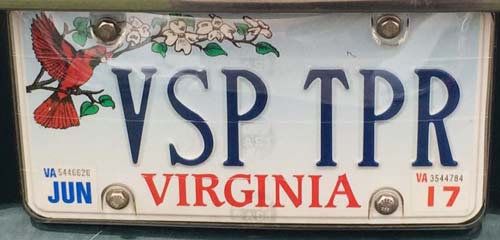 Personalized private vehicle issue.
Personalized private vehicle issue.